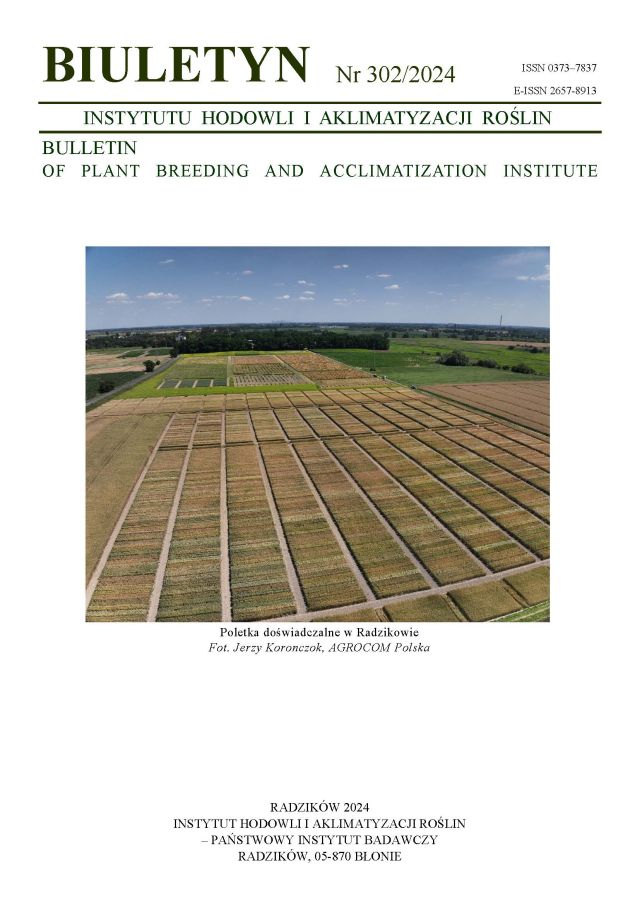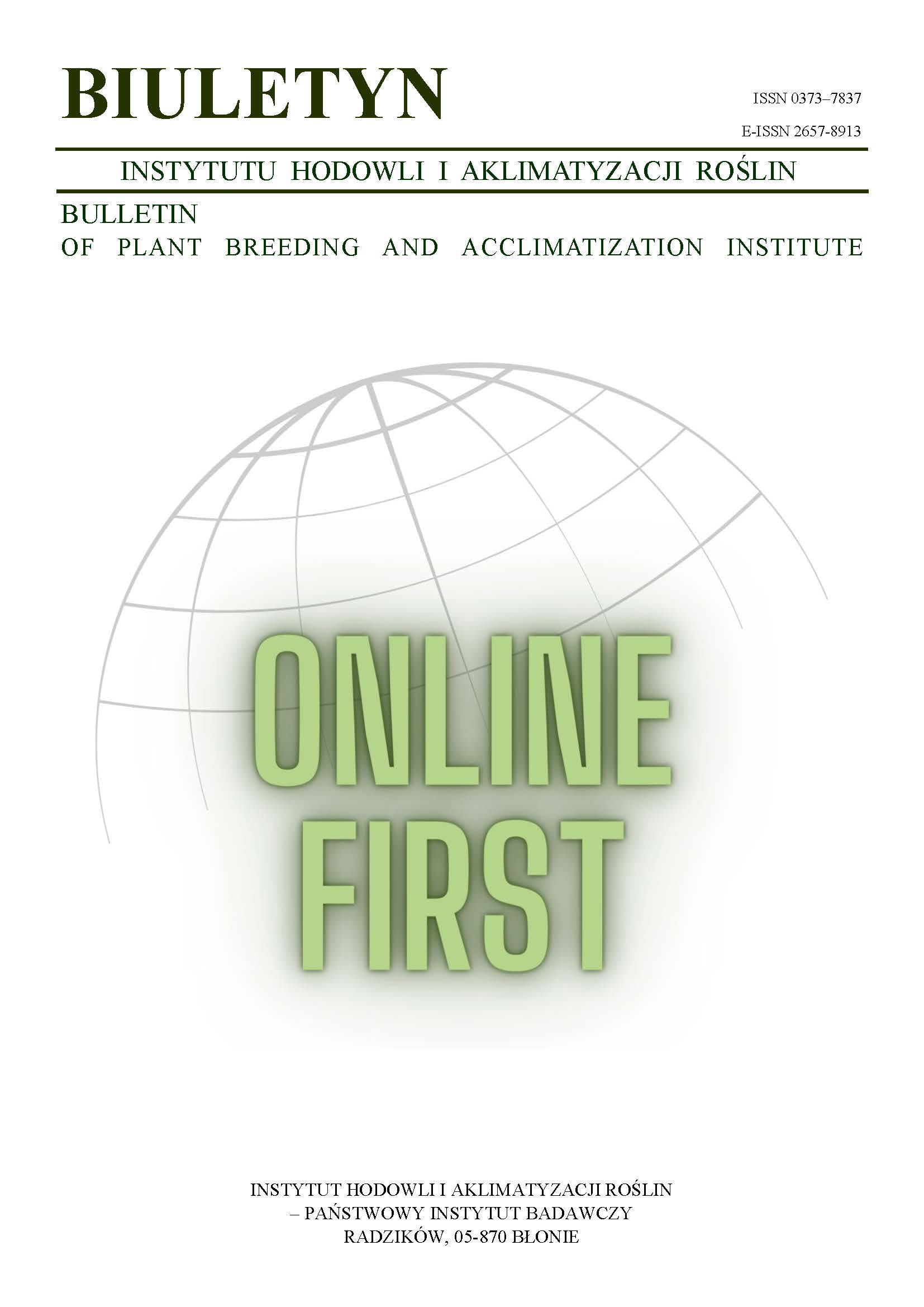Influence of different methods of haulm killing on rate of haulm desiccation and tuber yield of mid-early potato seed plantations
Sławomir Wróbel
s.wrobel@ihar.edu.plZakład Nasiennictwa i Ochrony Ziemniaka w Boninie, IHAR Radzików (Poland)
Abstract
The destruction of haulm is a conventional practice in potato cultivation. Potato haulm can be destroyed mechanically or chemically or with the combination of both means. In the presented study, the different haulm destruction techniques were compared for their efficacy in haulm desiccation and influence in potato tuber yield. The experiments were conducted on two mid early potato cultivars — Balbina and Mila in the years 2000–2002 in Bonin (zachodniopomorskie province). The mechanical haulm destruction was as efficient as the chemical treatment. However, the combination of mechanical and chemical method shortened time of haulm desiccation (for about 2 days) compared with chemical or mechanical haulm killing alone. Moreover, no haulm regrowth was observed. Early haulm destruction with all methods significantly reduced total yield of tubers only for the cultivar Mila (in average about 8%). There was no significant difference for both Balbina and Mila in the yield of seed tubers. According to our data, mechanical haulm destruction could be used as an alternative to chemical desiccation in organic farming.
Keywords:
haulm killing, potato, tuber yield, seed potatoReferences
Barry P. 1994. A note on the effect of time of haulm desiccation on the yield of potatoes grown from sprouted seed. Irish J. Agric. Food Res. 33 (1): 75 — 77.
Google Scholar
Erlichowski T. 2004. Skuteczność działania wybranych desykantów w uprawie ziemniaka jadalnego. Prog. Plant Prot. 44 (2): 668 — 671.
Google Scholar
Gąsior J. 1997. Wpływ wczesnego niszczenia naci ziemniaka i nawożenia azotem na wydajność sadzeniaków w warunkach gleb lekkich Płaskowyżu Kolbuszewskiego. Zesz. Nauk. AR Krak. 319, Rolnictwo 34: 81 — 91.
Google Scholar
Hebeisen T., Nemecek T. 2001. TuberPro optimiert Krautvernichtungstermin in Pflanzkartoffeln. Agrarforschung 8 (8): 312 — 317.
Google Scholar
Iskrzycka T., Łaniecka B. 1983. Wpływ niszczenia naci różnymi metodami na zdrowotność sadzeniaków 19 odmian ziemniaka. Biul. Inst. Ziemn. 30: 7 — 16.
Google Scholar
Kapsa E. 1968. Nowoczesne zabiegi w produkcji sadzeniaków ziemniaka. Hod. Rośl. Nasien. 2: 30 — 36.
Google Scholar
Kooistra T., Halteren P. 1991. Towards a reduction of chemical haulm killing in potato growing in the Netherlands. Bull. OEPP 21 (1): 27 — 31.
DOI: https://doi.org/10.1111/j.1365-2338.1991.tb00448.x
Google Scholar
Kürzinger W. 1999. Krautminderung in Kartoffelbeständen. Kartoffelbau 50(6): 224 — 226.
Google Scholar
Larsson K. 1992. Potatis. Nyteknik for blastdodning. Meddelande Jordbrukstekniska Institutet No. 438: s.73.
Google Scholar
Rongai D., Cerato C. 1997. Fore casting the best time for the desiccation of seed potato. Informatore Agrario 53, 17: 51 — 56.
Google Scholar
Schwarzel R. 1998. La date defanage des plants de pommes de terre. Rev. Suisse d’Agric. 30 (4): 137 — 141.
Google Scholar
Skuterud R., Krok R., Mollerhagen P. J., Steinsholt P. Y. 1995. Risdreping i potet. Fins det alternativ til dikvat? Norsk Landbruksforsking 9 (1–2): 39 — 49.
Google Scholar
Turska E. 1997. Czynniki wpływające na poziom porażenia sadzeniaków wirusami. W: Produkcja ziemniaków Technologia — Ekonomika — Marketing. Wydanie 2. IHAR Oddz. Bonin:162 — 166.
Google Scholar
Vokal B., Cepel J., Brecka J., Honzik I. 1996. Moznosti nahrady chemicke desikace pri pestovani sadbovych brambor. Vedecke Prace Vyzkumneho Ustavu Bramborarskeho Havlickov Brod 12: 87 — 95.
Google Scholar
Wróbel S. 2001. Efekt różnych sposobów niszczenia naci w ograniczaniu porażenia sadzeniaków ziemniaka wirusem Y. Prog. Plant Prot. 41 (2): 683 — 687.
Google Scholar
Wróbel S. 2004. Wpływ wybranych zabiegów agrotechnicznych w produkcji nasiennej ziemniaka na porażenie bulw wirusami Y i M. Rozprawa doktorska. IHAR ZNiOZ Bonin: 120 s.
Google Scholar
Authors
Sławomir Wróbels.wrobel@ihar.edu.pl
Zakład Nasiennictwa i Ochrony Ziemniaka w Boninie, IHAR Radzików Poland
Statistics
Abstract views: 11PDF downloads: 5
License
Copyright (c) 2005 Sławomir Wróbel

This work is licensed under a Creative Commons Attribution-ShareAlike 4.0 International License.
Upon submitting the article, the Authors grant the Publisher a non-exclusive and free license to use the article for an indefinite period of time throughout the world in the following fields of use:
- Production and reproduction of copies of the article using a specific technique, including printing and digital technology.
- Placing on the market, lending or renting the original or copies of the article.
- Public performance, exhibition, display, reproduction, broadcasting and re-broadcasting, as well as making the article publicly available in such a way that everyone can access it at a place and time of their choice.
- Including the article in a collective work.
- Uploading an article in electronic form to electronic platforms or otherwise introducing an article in electronic form to the Internet or other network.
- Dissemination of the article in electronic form on the Internet or other network, in collective work as well as independently.
- Making the article available in an electronic version in such a way that everyone can access it at a place and time of their choice, in particular via the Internet.
Authors by sending a request for publication:
- They consent to the publication of the article in the journal,
- They agree to give the publication a DOI (Digital Object Identifier),
- They undertake to comply with the publishing house's code of ethics in accordance with the guidelines of the Committee on Publication Ethics (COPE), (http://ihar.edu.pl/biblioteka_i_wydawnictwa.php),
- They consent to the articles being made available in electronic form under the CC BY-SA 4.0 license, in open access,
- They agree to send article metadata to commercial and non-commercial journal indexing databases.
Most read articles by the same author(s)
- Józefa Kapsa, Marek Mrówczyński, Tomasz Erlichowski, Hanna Gawińska-Urbanowicz, Konrad Matysek, Jerzy Osowski, Maria Pawińska, Janusz Urbanowicz, Sławomir Wróbel, Potato protection according to the principles of integrated pest management. Part II. Sustainable method of chemical potato protectio , Bulletin of Plant Breeding and Acclimatization Institute: No. 273 (2014): Regular issue
- Józefa Kapsa, Marek Mrówczyński, Tomasz Erlichowski, Hanna Gawińska-Urbanowicz, Konrad Matysek, Jerzy Osowski, Maria Pawińska, Janusz Urbanowicz, Sławomir Wróbel, Potato protection according to the principles of integrated pest management. Part I. Non-chemical methods of protection , Bulletin of Plant Breeding and Acclimatization Institute: No. 273 (2014): Regular issue
- Sławomir Wróbel, Effects of fertilization of potato cultivar Jelly with foliar fertilizers YaraVita Ziemniak and Actisil , Bulletin of Plant Breeding and Acclimatization Institute: No. 266 (2012): Regular issue
- Sławomir Wróbel, Barbara Robak, New potato cultivars characterized in regard to dormancy breaking of tubers , Bulletin of Plant Breeding and Acclimatization Institute: No. 272 (2014): Regular issue
- Sławomir Wróbel, Adjuvants in seed potato protection against PVY and PVM infection , Bulletin of Plant Breeding and Acclimatization Institute: No. 259 (2011): Regular issue
- Janusz Urbanowicz, Sławomir Wróbel, Response of potato plants of the cultivar Mila to some adjuvants used in seed crop protection , Bulletin of Plant Breeding and Acclimatization Institute: No. 237/238 (2005): Regular issue
- Sławomir Wróbel, Optimal agro-practices to control PVY in potatoes , Bulletin of Plant Breeding and Acclimatization Institute: No. 237/238 (2005): Regular issue
- Sławomir Wróbel, Ewa Turska, The new potato cultivars in seed production , Bulletin of Plant Breeding and Acclimatization Institute: No. 237/238 (2005): Regular issue
- Sławomir Wróbel, Ewa Turska, Possibility of application of bed planting in seed potato production , Bulletin of Plant Breeding and Acclimatization Institute: No. 232 (2004): Regular issue














